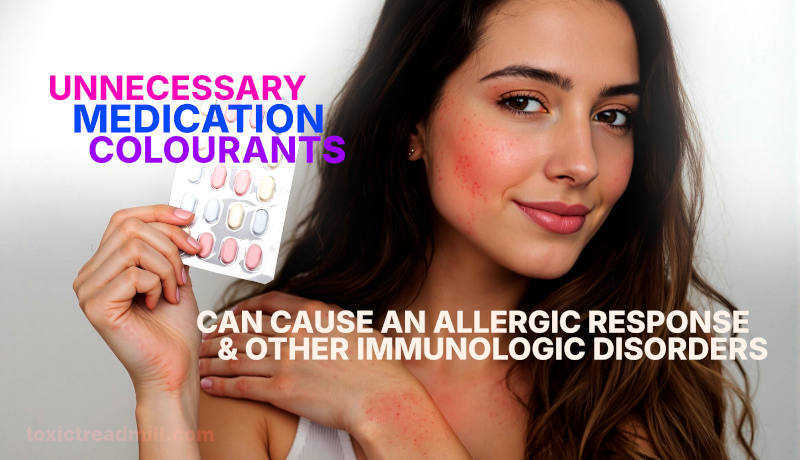Toxic Treadmill
Evidence for a Poisoned Planet
How Pharmaceuticals Poison People
Prescription pharmaceutical medications effectively treat a broad spectrum of health conditions. However, they also pose a significant health hazard. The danger stems not only from the intrinsic pharmacological activity of the active compounds, but also from numerous factors inherent in their formulation, manufacture, distribution, prescribing, and environmental disposal. Most people are aware of direct side effects and potential toxic effects during ordinary use. Most are probably unaware of the dangers arising from excipients, fillers, industrial contaminants, and colouring agents incorporated into formulations. Indeed, many of the side effects reported in connection with medications are likely caused by the inclusion of additional ingredients, many of which are not necessary.
Other problems arise from issues such as incorrect dosage, flawed medical guidance including the use for non-approved conditions (off-label use), fraudulent practices in regulatory approval and sales, fraudulent manufacturing with the inclusion of untested or unsafe ingredients, unscreened synergistic interactions with other concurrently administered medications or over-the-counter (OTC) drugs, allergenicity, and secondary exposure through environmental contamination.

Direct Adverse Effects: Side Effects and Toxicity
The therapeutic use of prescription medications is accompanied by well-recognized side effects and toxic responses that can range from mild discomfort to severe, life-threatening conditions. For instance, drugs used for the treatment of attention deficit hyperactivity disorder (ADHD) are well-known to induce cardiovascular stress by increasing heart rate and blood pressure, and in some cases may contribute to chronic heart failure and cardiomyopathy. Many agents exhibit dose-dependent toxicity, whereby even small errors in dosing may precipitate major adverse events, a factor compounded by the narrow therapeutic indices of certain drugs. Moreover, non-therapeutic and off-target effects may emerge unexpectedly as a consequence of metabolic by-products and long-term accumulation in the body, occasionally resulting in systemic toxicity that further complicates treatment outcomes.
Excipients, Fillers, Industrial Contaminants, and Colouring Agents
Formulation additives such as fillers, industrial contaminants, and colouring agents represent another significant source of potential harm. Synthetic dyes, commonly used to impart a distinct visual appeal and identification to medications, have been linked to allergic reactions, dermatitis, and even more severe immunologic responses in susceptible individuals. For example, tartrazine (E102) and quinoline yellow (E104) have been linked to acute allergic phenomena such as urticaria and asthma. They have also shown genotoxic, and possibly carcinogenic, effects under certain conditions. In addition to dyes, fillers, and other inert substances used in tablets and capsules can occasionally trigger adverse immunologic responses, particularly in patients with pre-existing sensitivities, thereby contributing to the overall toxicity profile of the medication.
Industrial contaminants may enter the pharmaceutical supply chain via manufacturing solvents and processing aids, such as dimethylformamide (DMF). These contaminants, even in minute levels, have the potential to cause carcinogenic effects when present in drug batches. Inclusion often arises from lapses in quality control, and suboptimal cleaning procedures. High-profile product recalls have raised significant concerns regarding patient safety and regulatory oversight. Furthermore, fillers and colourants that have not been sufficiently evaluated for long-term safety may also unpredictably interact with the active pharmaceutical ingredient, or other medications, potentially exacerbating adverse outcomes.

Incorrect Dosage and Improper Guidance
Medication errors resulting from incorrect dosage and inadequate prescribing guidance remain a major contributor to adverse drug events (ADRs) and medication toxicity. E-prescribing errors, such as the entry of erroneous dosing instructions or the selection of an incorrect formulation, can significantly compromise therapeutic efficacy while simultaneously increasing the risk of toxicity or treatment failure. These mistakes frequently occur during transitions of care, particularly in home and community settings where polypharmacy, and the absence of robust oversight, compound the likelihood of errors. Incorrect dosing exposes patients to either subtherapeutic effects that may lead to treatment failure or supratherapeutic exposures that can precipitate life-threatening toxicities.
Moreover, improper medical guidance about how and when medications should be taken can result in harmful side effects that would otherwise be avoided under correct usage protocols. The inherent complexity of drug regimens—especially among elderly populations with multiple comorbidities—necessitates precise instructions and vigilant monitoring, failure of which leads to errors in administration, missed doses, or overuse, each carrying its own spectrum of potential toxicities.
Use for Non-Approved Conditions and Off-Label Use
The practice of off-label use (prescribing medications for indications that have not been formally approved by regulatory authorities) introduces unpredictable risk profiles into the therapeutic equation. Off-label prescribing, though sometimes clinically justified in the absence of effective alternatives, often lacks robust evidence regarding efficacy and safety, thereby increasing the risk of adverse effects and toxicities when used extensively. In many cases, medications that are approved for narrow, well-defined indications are repurposed for off-label uses without adequate clinical data to support such practices. This creates potential for unforeseen synergistic or antagonistic interactions when drugs are combined in non-standard regimens.
In some instances, off-label use is compounded by incorrect dosing and divergence from protocols studied in clinical trials. This can increase the incidence and severity of side effects, toxicity, and reduce therapeutic efficacy. Again, this adds to the risk of adverse drug reactions that can have long-term detrimental impacts on health.

Fraudulent Practices in Regulatory Approval and Sales
There exists a disturbing body of evidence that points to fraudulent practices in pharmaceutical marketing and regulatory approval processes, which have far-reaching implications for patient safety. Instances of manufacturing fraud, where companies deliberately conceal the existence of impurities, or misrepresent the efficacy and safety data of their products, have been documented in many high-profile cases. Such practices are criminal and expose patients to ingredients that may be harmful.
Untested ingredients are not solely included by accident. Fraudulent manufacturing practices include the use of unapproved substitutes and cheap, impure raw materials. Widespread distribution of counterfeit or adulterated medications can result in severe adverse outcomes including toxicity, secondary infections, and, in extreme cases, death. Economic pressures and competitive market forces have driven companies to prioritize rapid market entry over thorough safety evaluations. Circumventing standard regulatory safeguards intended to protect patient health enhances profitability. Such unethical practices rightly undermine public trust in the pharmaceutical industry because they lead to direct harm by exposing patients to formulations with unpredictable pharmacodynamic properties.
Unscreened Synergistic Effects and Interactions with Other Medications
The issue of unscreened synergistic effects arises when multiple medications, including both prescription and OTC products, are administered concurrently without thorough investigation into their interactive properties. Often, patients may inadvertently take combinations of drugs that, when combined, produce effects that exceed the expected pharmacological response of either agent alone. This can enhance toxicity and cause unexpected adverse reactions. These interactions can be particularly perilous when medications share common metabolic pathways, or have overlapping side effect profiles. For example, unexpected sedative effects can occur through the concurrent use of antipsychotic medications, antihistamines, and other central nervous system depressants. This increases the risk of respiratory depression and related complications.
In addition to well-characterized drug–drug interactions, unscreened synergistic effects may also occur through the interaction of prescription medications with commonly available OTC drugs, herbal supplements, or even environmental contaminants that share pharmacological targets. The unpredictable nature of these interactions, coupled with the lack of comprehensive screening in many clinical settings, makes it challenging for healthcare providers to anticipate and mitigate adverse outcomes. This gap in knowledge significantly complicates patient management, particularly in scenarios of polypharmacy, where the cumulative burden of multiple medications may lead to deleterious effects far beyond what is observed with monotherapy.
Allergenicity and Immunological Reactions
Allergenic reactions represent another critical area of concern when considering the broader spectrum of pharmaceutical hazards. In addition to the well-known side effects of the active ingredient, components such as excipients, fillers, and colouring agents can also provoke immunological reactions in susceptible individuals. For instance, patients with known hypersensitivities may experience severe allergic responses such as urticaria, eczema, or even anaphylactic shock upon exposure to specific synthetic dyes or preservatives. These allergenic responses are not always anticipated during the drug development process, particularly when the focus is predominantly on the efficacy of the API, rather than on the inert ingredients.
The risk of allergenicity is further heightened in paediatric populations and in individuals with pre-existing allergies, as the cumulative exposure to multiple medications containing allergenic excipients in various formulations may lead to sensitization or exacerbation of allergic conditions over time. The potential for repeated re-exposure to allergenic substances through repeated dosing or environmental contamination underlines the necessity for enhanced vigilance and improved labelling practices to ensure that vulnerable populations are adequately informed of potential risks.
Exposure of Non-Medicated Populations Through Environmental Contamination
Beyond the direct use of pharmaceuticals by patients, environmental contamination arising from improper disposal, manufacturing waste, and excretion. Active pharmaceutical ingredients, along with associated excipients and industrial contaminants, are frequently released into wastewater systems, eventually contaminating surface waters, groundwater, and even drinking water. Such contamination has been documented across diverse geographic regions and has been linked to adverse outcomes, including the disruption of endocrine function and the promotion of antimicrobial resistance in aquatic organisms.
The consequences of environmental exposure are particularly worrisome for non-medicated populations, including children and other vulnerable groups. Continuous low-level exposure to pharmaceuticals, their metabolites, industrial contaminants, and unscreened formulation additives poses a danger to long-term public health including increased risk of cancer, reproductive toxicity, and neurodevelopmental disorders. Many conventional wastewater treatment systems inadequately filter these compounds and testing regimes may not include them.
Fraudulent Manufacturing and the Inclusion of Untested or Unsafe Ingredients
Manufacturing shortcuts and unethical practices have led to the circulation of counterfeit, substandard, or contaminated medications that bypass rigorous regulatory safeguards. Such products may contain hazardous impurities, incomplete amounts of the intended active ingredient, or even deleterious substances that significantly deviate from the approved composition. The intentional manipulation of pharmaceutical formulations to achieve economic gains by some manufacturers not only compromises drug efficacy but also introduces acute and chronic health risks that are often difficult to detect without specialized analytical methods.
Fraudulent practices may extend to the mislabelling of drugs and the concealment of adverse safety data during the regulatory approval process. A deliberate method of misleading healthcare providers and patients alike. Such practices can cause unexpected toxicities, immunogenic reactions to unapproved additives, and add to the long-term burden on public health systems.

Unintended Re-Exposure and Secondary Exposure Through the Environment
Secondary exposure can occur when individuals who have not directly taken a medication are nevertheless exposed to pharmaceutical contaminants through environmental pathways. This form of re-exposure is of significant concern in densely populated urban areas where improper disposal of expired or unused medications, coupled with insufficient wastewater treatment, leads to the pervasive dissemination of drugs into the environment. Children, due to their developing physiology and higher relative rates of exposure, are particularly vulnerable to such secondary exposure, which may result in unexpected toxicological outcomes and developmental impairments.
The concept of eco-pharmacovigilance has been introduced as a means to monitor and mitigate these indirect exposures by tracking the environmental fate of pharmaceuticals from production through disposal. However, despite growing awareness of these challenges, gaps in regulatory frameworks and environmental monitoring persist, leaving large segments of the population at risk for chronic low-dose exposure to pharmacologically active substances.
Summary
Prescription pharmaceutical medications, while critical for the effective management of various health conditions, carry an extensive array of health hazards and harms that extend beyond their intended therapeutic effects. These hazards encompass direct adverse effects such as side effects and dose‐dependent toxicity. However, significant additional risk comes from excipients, fillers, industrial contaminants, colouring agents, improper dosing, incorrect medical guidance, off‐label use, fraud, and other criminal activity. Unscrutinized synergistic interactions between medications, the risk of allergenicity, and the eventual environmental contamination that leads to secondary exposure further compound the risk profile of prescription medications. Without better practitioner education, a significant increase in robust regulation and enforcement, and a holistic understanding of the long-term risks associated with pharmaceutical products, the situation looks dire.
References
Argaluza, J., Domingo-Echaburu, S., Orive, G., Medrano, J., Hernandez, R., & Lertxundi, U. (2021). Environmental pollution with psychiatric drugs. World journal of psychiatry, 11(10), 791.
Assiri, G. A., Shebl, N. A., Mahmoud, M. A., Aloudah, N., Grant, E., Aljadhey, H., & Sheikh, A. (2018). What is the epidemiology of medication errors, error-related adverse events and risk factors for errors in adults managed in community care contexts? A systematic review of the international literature. BMJ open, 8(5), e019101.
Ausness, R. C. (2021). Corporate Misconduct in the Pharmaceutical Industry. DePaul L. Rev., 71, 1.
Chandran, P., Suresh, S., Balasubramain, B., Gangwar, J., Raj, A. S., Aarathy, U. L., ... & Sebastian, J. K. (2023). Biological treatment solutions using bioreactors for environmental contaminants from industrial waste water. Journal of Umm Al-Qura University for Applied Sciences, 1-23.
Campbell, H. R. (2021). Towards a Holistic Risk Model for Safeguarding the Pharmaceutical Supply Chain: Capturing the Human-induced Risk to Drug Quality [Doctoral dissertation--Pharmacy. 131. University of Kentucky].
Freitas, L. D. A. A., & Radis-Baptista, G. (2021). Pharmaceutical pollution and disposal of expired, unused, and unwanted medicines in the Brazilian context. Journal of xenobiotics, 11(2), 61-76.
Odukoya, O. K., Stone, J. A., & Chui, M. A. (2014). E-prescribing errors in community pharmacies: exploring consequences and contributing factors. International journal of medical informatics, 83(6), 427-437.
Schifano, F., Chiappini, S., Miuli, A., Mosca, A., Santovito, M. C., Corkery, J. M., ... & Martinotti, G. (2021). Focus on over-the-counter drugs' misuse: a systematic review on antihistamines, cough medicines, and decongestants. Frontiers in psychiatry, 12, 657397.
Šuleková, M., Smrčová, M., Hudák, A., Heželová, M., & Fedorová, M. (2017). Organic colouring agents in the pharmaceutical industry. Folia Vet, 61(3), 32-46.
Vatovec, C., Van Wagoner, E., & Evans, C. (2017). Investigating sources of pharmaceutical pollution: Survey of over-the-counter and prescription medication purchasing, use, and disposal practices among university students. Journal of environmental management, 198, 348-352.
Vida, R. G., Merczel, S., Jáhn, E., & Fittler, A. (2020). Developing a framework regarding a complex risk based methodology in the evaluation of hazards associated with medicinal products sourced via the internet. Saudi Pharmaceutical Journal, 28(12), 1733-1742.